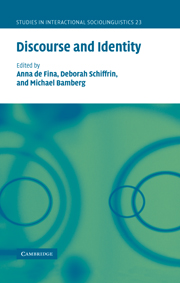Book contents
- Frontmatter
- Contents
- List of contributors
- Introduction
- Part I Overview: theory, method and analysis
- Part II Private and public identities: constructing who we are
- Part III The gendered self: becoming and being a man
- Part IV The in-between self: negotiating person and place
- Editors' introduction
- 13 Group identity, narrative and self-representations
- 14 Performing self, family and community in Moroccan narratives of migration and settlement
- 15 Making it personal: shared meanings in the narratives of Holocaust survivors
- References
- index
Editors' introduction
Published online by Cambridge University Press: 09 November 2009
- Frontmatter
- Contents
- List of contributors
- Introduction
- Part I Overview: theory, method and analysis
- Part II Private and public identities: constructing who we are
- Part III The gendered self: becoming and being a man
- Part IV The in-between self: negotiating person and place
- Editors' introduction
- 13 Group identity, narrative and self-representations
- 14 Performing self, family and community in Moroccan narratives of migration and settlement
- 15 Making it personal: shared meanings in the narratives of Holocaust survivors
- References
- index
Summary
The chapters that form the closing part of this volume analyze narrative data produced by people who have gone through fundamental and, in certain cases, deeply traumatic changes in their life. De Fina and Baynham look at immigrant discourse, while Schiff and Noy study the life story of a Holocaust survivor. As noted by Baynham in the introduction to his chapter, the experience of change and of physical or moral displacement leads people to revisit and question their past inventory of identities in order to rebuild a sense of self. In this regard, the types of narratives analyzed in this section are an ideal locus to study the discursive construction and negotiation of identity. The three chapters deal with interview data and in all of them interviewers and interviewees are shown grappling with the need to understand and give meaning to complex past experiences that led narrators to claim their present identities, but also to establish common ground or differences and confront each other on the adequacy of categories socially established to describe human experience. In this process, the analysts, who were also interviewers, rediscover the importance of looking at identity as something that is done on the basis of both, the stable and the innovative, the known and the unknown.
Thus a common thread running through the three chapters is an interrogation on the nature of the relationship between individual and collective identities, creative expression and social mould, and therefore also a reflection on social constructionism as a frame of reference.
- Type
- Chapter
- Information
- Discourse and Identity , pp. 345 - 350Publisher: Cambridge University PressPrint publication year: 2006
- 2
- Cited by

